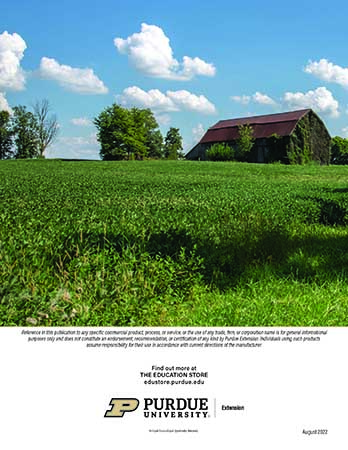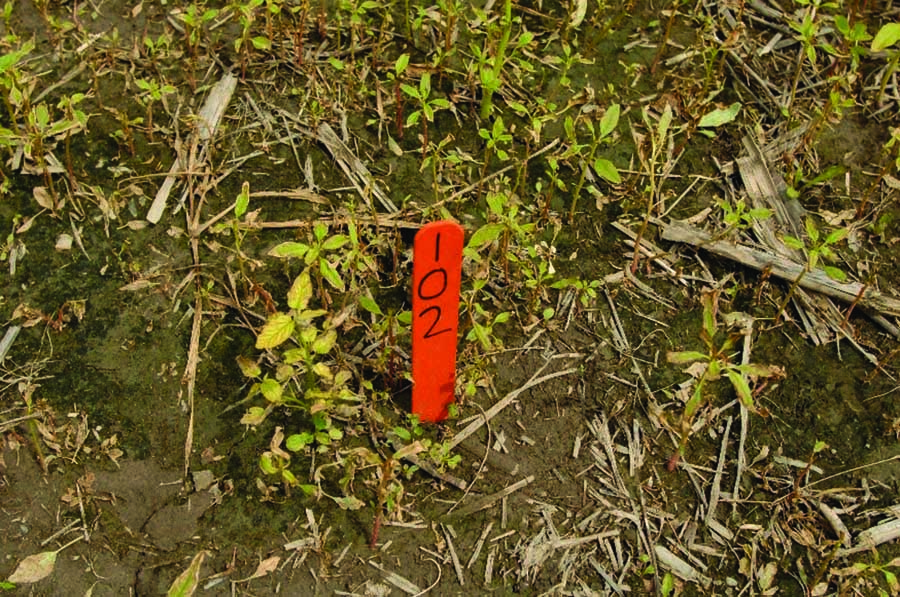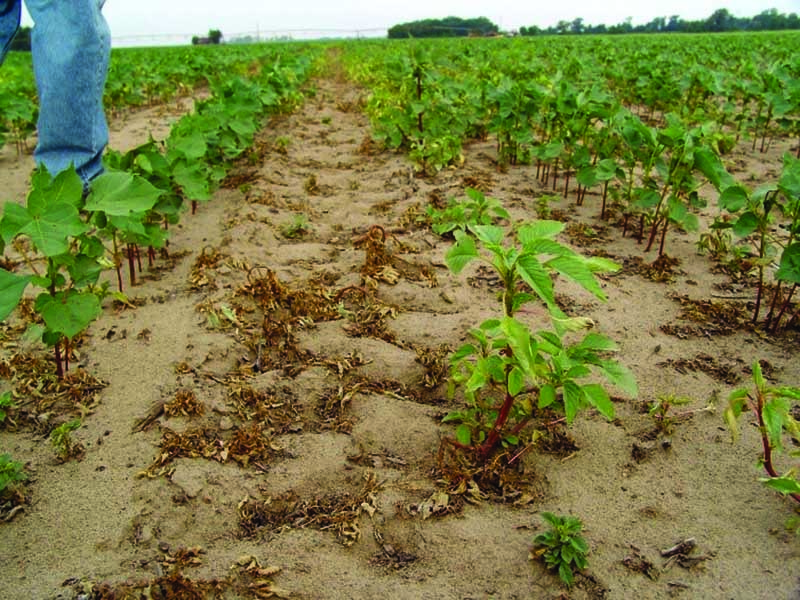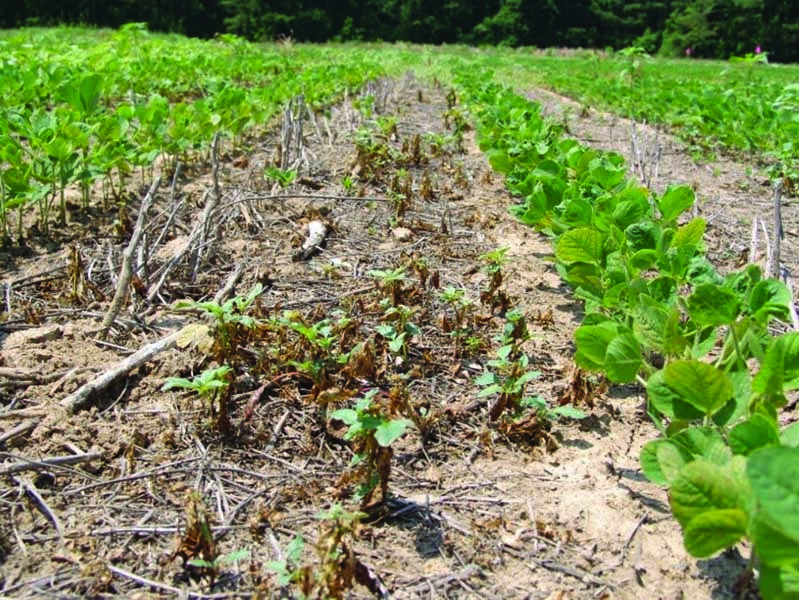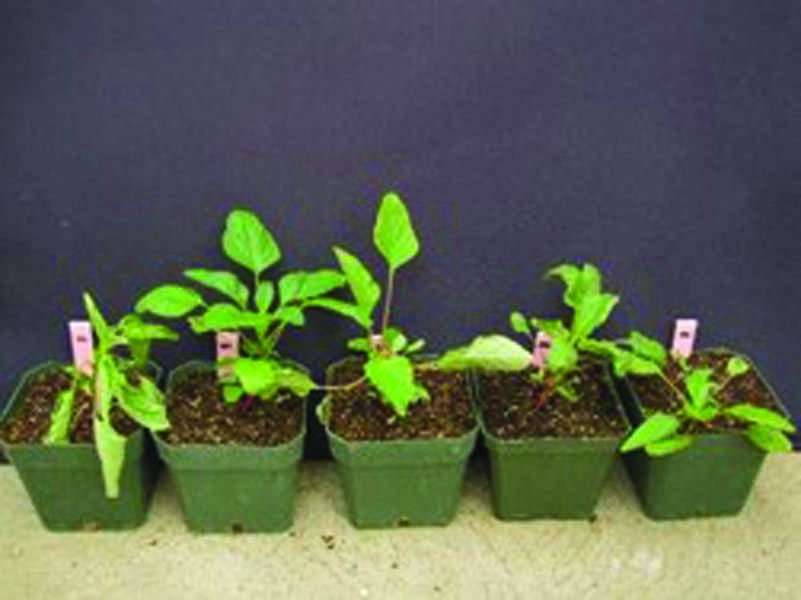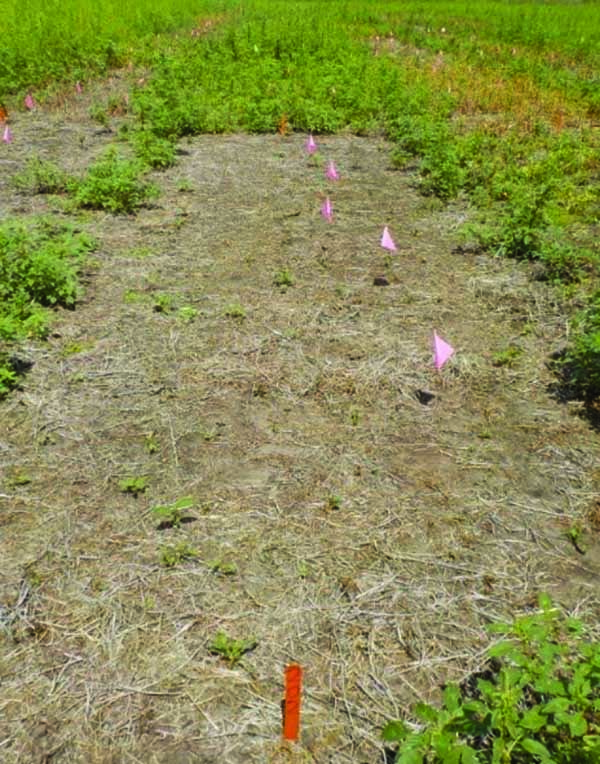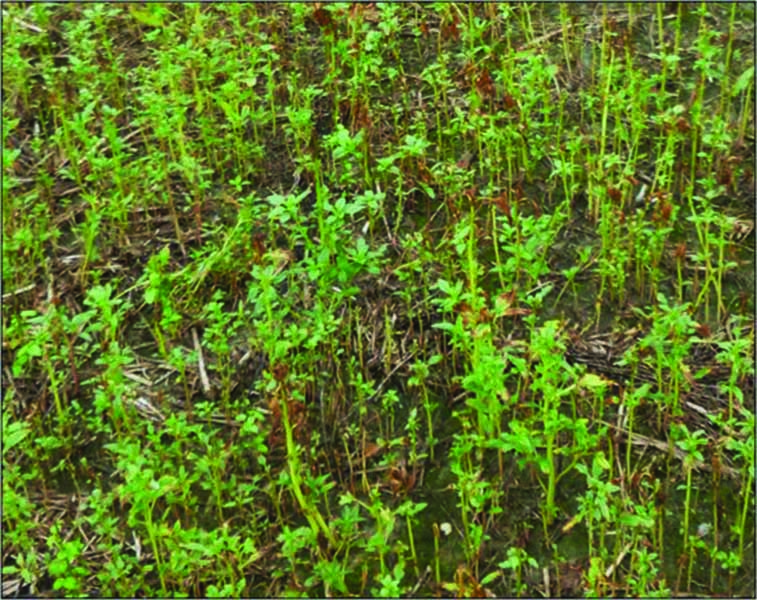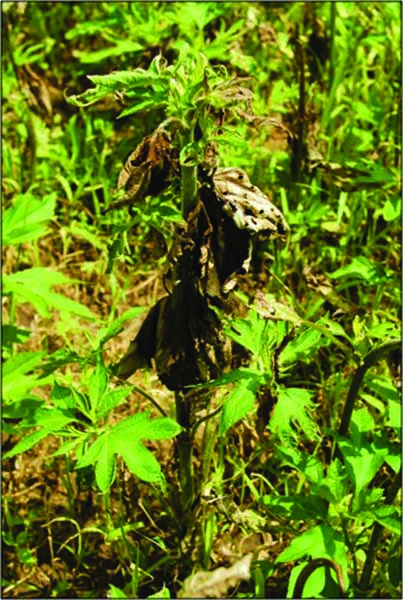A Soybean Postemergence Herbicide Failed To Perform, Is Retreatment Warranted?

Jesse A. Haarmann, Graduate Research Assistant in Weed Science, Purdue University
William G. Johnson, Professor of Weed Science, Purdue University
Fred Whitford, Director, Purdue Pesticide Programs
Tomas F. Delucchi, Graduate Research Assistant in Weed Science, Purdue University
Marcelo Zimmer, Weed Science Program Specialist, Purdue University
Bryan G. Young, Professor of Weed Science, Purdue University
Larry Steckel, Professor of Weed Science, University of Tennessee
Vince Davis, Technical Service Representative, BASF Corporation
Kevin Leigh Smith, Continuing Lecturer and Communication Specialist, Purdue Agricultural Sciences Education and Communication
Successful Herbicide Applications Depend on Many Factors………………………………………………………………4
Herbicides Are an Important Weed Management Tool………………….5
Identify Herbicide Failure as Soon as Possible………8
Respray Decision Making…………………………………………… 12
Questions You Should Ask……………………………………………………… 13
What Do the Labels Say About Respray Applications?……………….. 13
What Does the Research Say?………………………………………………… 14
Findings and Recommendations from the Field Studies…………….. 16
Conclusions…………………………………………………………………… 20
Acknowledgments………………………………………………………. 22
Disclaimer………………………………………………………………………. 22
Successful Herbicide Applications Depend on Many Factors
Farmers and agronomists know that smaller weeds are easier to control with postemergence herbicides than larger weeds. Unfortunately, high winds, excessive rain, or other challenges like equipment failures can often delay postemergence herbicide applications to soybean fields by days or even weeks.
Weeds, however, don’t stop growing while the application equipment is parked. Under these circumstances, growers often have little choice but to apply the herbicides even if the weeds are larger than what herbicide labels recommend.
Fortunately, herbicide applications often provide adequate control even when made under less-than-ideal conditions. However, there are times when weed control is unacceptable, and fields may require a second application to achieve acceptable control of the remaining weeds. There is a problem if the first postemergence (POST) attempt in soybean fields provides poor weed control. There are fewer herbicide options as soybeans continue to develop and the calendar marches on.
A number of questions arise when considering whether to make a second herbicide treatment in soybeans, including:
• Do I spray as soon as I notice that too many weeds are still green?
• Do I let injured weeds regrow a little to get new leaf tissue?
• Which herbicide should I use and why?
This publication addresses these questions by providing guidelines about timing second applications in soybean and about how to select herbicide options that work best based on university research and the experience of agronomists in the crop protection industry. Specifically, the recommendations we provide focus primarily on controlling waterhemp and Palmer amaranth, because the herbicide programs that control them are complex and both species have resistance-related challenges in soybean.
Herbicides are an important weed management tool
Growers rely heavily on herbicides to control weeds in soybean. There are several application factors to consider to ensure herbicides work best. The most successful control meets all these factors:
• The right herbicide
• The right rate
• The right adjuvants
• The right timing
• The right equipment calibration
• The right environmental conditions
Herbicides interfere with a weed’s biological processes, and plant death requires the herbicide mixture to overcome a number of physical and chemical barriers. For POST-applied herbicides to be successful, a target plant must intercept a sufficient amount of the spray solution’s active ingredient, absorb that ingredient into its leaves, and then translocate the ingredient to the site of action where it disrupts plant growth. Any reduction in the amount of herbicide that reaches the target site can reduce weed control.
Weeds have rapid vegetative growth. The weeds on the (center) have less than 4 inches of growth, which is near the perfect time to receive a first POST application. One week later (right) the weeds have grown quickly leaving little time to delay the POST herbicide application.
Other factors that are largely beyond an applicator’s control can also reduce how well herbicides work.
The first factor is how quickly the plant absorbs the herbicide. Plants absorb some herbicides in less than an hour, while others require several hours for adequate absorption. A rule of thumb is to assume that herbicides need four hours to penetrate a plant and reach the site of action. If it rains while the herbicide is on the plant’s surface, the herbicide will be less likely to perform as intended.
Environmental factors (such as drought or extreme heat) can influence herbicide absorption rates. Under drought conditions, plants produce thicker wax on their leaves called cuticles, which help prevent water loss to the atmosphere. The thicker wax may also reduce the amount of herbicide that plants absorb. Under extreme heat, plants stop active growth to endure heat stress, which in turn may reduce herbicide translocation in the plant. In short, drought and extreme heat can reduce the amount of herbicide that reaches the target site.
The final factor that reduces herbicide activity is herbicide resistance in weeds. Resistance is the ability of weeds to survive exposure to active ingredients in herbicides that would have normally killed the weed. After repeated herbicide use, individual plants with a genetic resistance trait (which is initially extremely low in frequency in the overall plant population) will survive while the susceptible plants are killed. Those herbicide-resistant plants are left to produce seed and can quickly multiply, increasing the frequency of resistance within a weed population. With time, those weeds can take over a field and lead to failures of herbicides to control the population.
Weeds such as giant ragweed, marestail (horseweed), and waterhemp have evolved resistance to glyphosate in most fields in Indiana. Applicators frequently use PPO-inhibiting herbicides (Group 14, such as Flexstar®, Cobra®, and Blazer®) to control glyphosate-resistant species such as waterhemp, Palmer amaranth, and giant ragweed in soybean. Unfortunately, repeated use of PPO-inhibiting herbicides as a glyphosate alternative has given rise to PPO resistance developing in waterhemp and Palmer amaranth.
It is essential to follow best management practices that include using multiple, effective herbicide modes of action to delay the evolution of herbicide resistance in weeds. Many growers already use preemergence herbicides and multiple modes of action to control glyphosate-resistant weed species in soybean.
Find Out More
More information about the resistance for specific weed species and herbicides are available at weedscience.org.
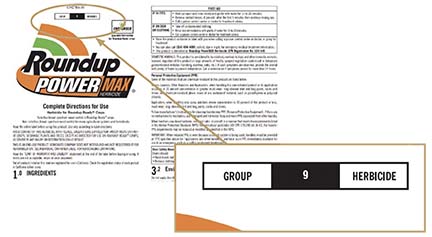
Identify Herbicide Failure as Soon as Possible
We have discussed situations that maximize herbicide performance and some of the factors that cause POST herbicides to fail. Everybody tries to maximize herbicide effectiveness and minimize trips through the field. Unfortunately, herbicide failures will still happen when applicators need to treat millions of soybean acres in a four- to six-week period.
It is critical to scout soybean fields following POST applications in a timely fashion to identify poor herbicide performance. When to scout depends on the herbicide that was sprayed. For contact herbicides (such as Liberty® and Flexstar®), scout soybean fields as early as three to five days after applications because they act quickly. However, systemic herbicides (such as glyphosate and dicamba) act more slowly, so herbicide failure may not be evident for two to three weeks. This means you should begin scouting one week after applications and you should revisit fields at least once to confirm that herbicides are working.
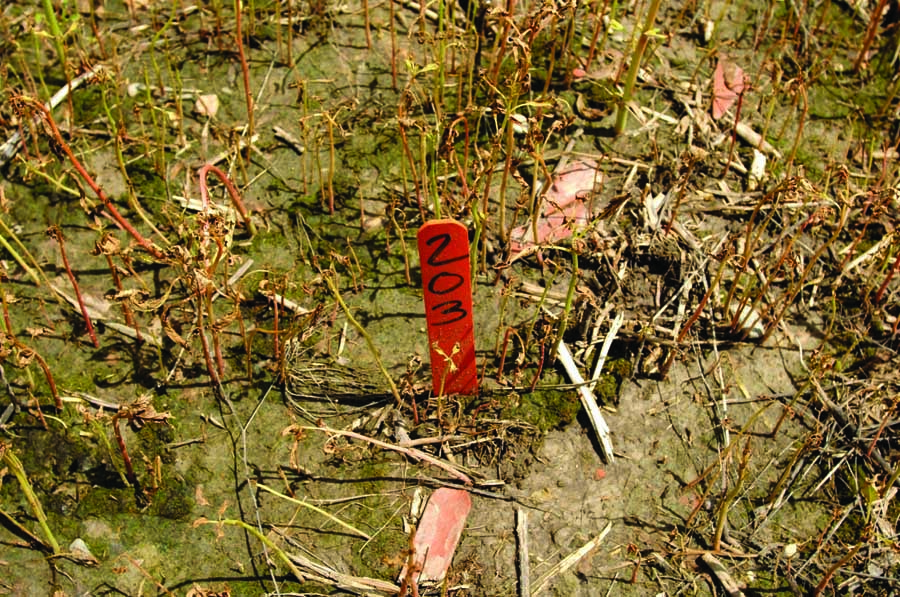 This photo shows waterhemp plants seven days after a failed Liberty® application. Although all plants are severely injured, some stems are brown and collapsing while others are still green. Keep an eye on the green-stemmed weeds, because they can regrow. The difference between these two is subtle, yet detectable and very important.
This photo shows waterhemp plants seven days after a failed Liberty® application. Although all plants are severely injured, some stems are brown and collapsing while others are still green. Keep an eye on the green-stemmed weeds, because they can regrow. The difference between these two is subtle, yet detectable and very important. 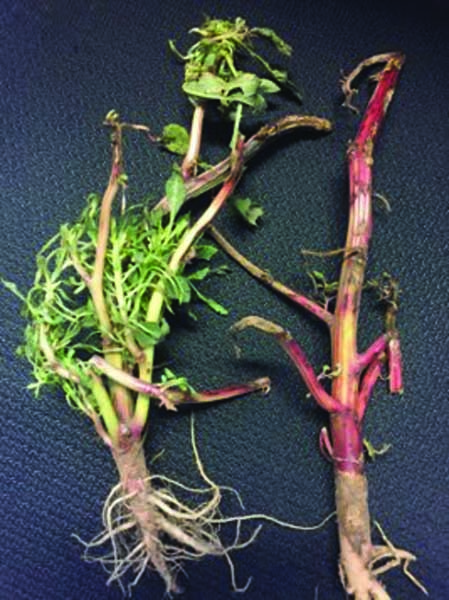 This image shows a recovering plant and a dead one after a dicamba application. Numerous branches are emerging from the recovering plant even while it is still showing twisting and cupping symptoms.
This image shows a recovering plant and a dead one after a dicamba application. Numerous branches are emerging from the recovering plant even while it is still showing twisting and cupping symptoms.  This photo shows a plant that is recovering from a dicamba application. Injured plants can be more difficult to control even with a second POST applicaton.
This photo shows a plant that is recovering from a dicamba application. Injured plants can be more difficult to control even with a second POST applicaton. 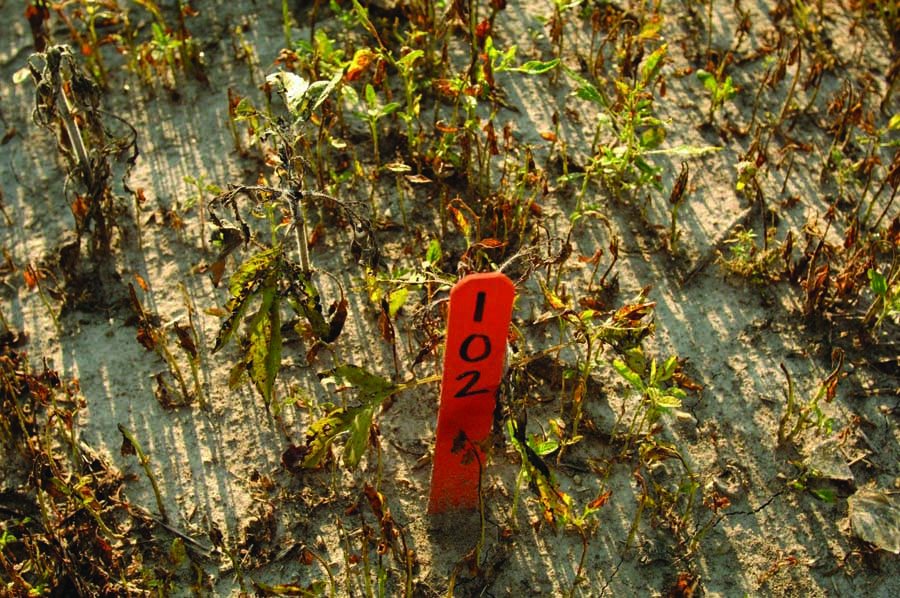 This photo shows waterhemp plants 10 days after a failed Flexstar® application. You can see some of the plants are dead while others are regrowing.
This photo shows waterhemp plants 10 days after a failed Flexstar® application. You can see some of the plants are dead while others are regrowing. If you observe any new growth after applying contact herbicides (Groups 10 and 14), it likely means the plant will survive. Dead plants will have brown and desiccated stems. Use a knife to split the stems between active growing points to determine if the plant is dead or has the potential to regrow.
It is more difficult to evaluate regrowth potential with systemic herbicides, especially Group 4 (synthetic auxins) herbicides. If symptoms on injured weeds do not progress for an entire week, then it is likely the application was unsuccessful. We suggest looking further down plant stems when you evaluate Group 4-treated plants. The tops of plants may not recover, but new growth from lower nodes often looks healthier and can indicate escaped plants.
The Symptoms and Signs of Herbicide Injury table provides the main herbicide mode of action groups used in soybeans, what symptoms to look for, when symptoms may be expected to develop, and signs of herbicide failure.

Respray Decision Making
The two most important factors that determine whether you should respray a field are:1. The number of uncontrolled weeds
2. The cost of a second application
You should not only consider the potential financial return for preserving soybean yield, but also the benefits of reducing next year’s weed seed bank. In practice, this means that respraying is the correct decision for any weed that has documented herbicide resistance, is difficult to control, and/or will produce enough seed to increase the cost of herbicide applications in future years.
Weeds specialize in producing seed under the most adverse conditions, including after herbicide applications. In general, the more a plant is injured, the fewer seeds it produces. If you consider that a single female waterhemp or Palmer amaranth plant can produce up to 500,000 seeds, then you can see how leaving a number of these weeds uncontrolled can significantly add to the weed seedbank in the soil. If those seed-producing weeds are also herbicide-resistant, then that population will be more abundant and more difficult to control in subsequent years. For this reason, troublesome weeds (such as Palmer amaranth and waterhemp) should prompt growers to take extra control measures that will minimize their seed production — not simply reduce competition.
QUESTIONS YOU SHOULD ASK
When follow-up herbicide treatments are warranted due to herbicide failures, it’s important to consider your herbicide choice, proper herbicide rate, timing, and sprayer setup. Before you do anything, try to diagnose the reasons why the herbicide failed to control the weeds in the first place, so you do not repeat the same costly mistake twice. If the problem was the wrong nozzle, too low of carrier volume, wrong herbicide rate, wrong herbicide product, wrong adjuvant, adverse weather conditions, or the weeds were just too large, then correct those mistakes where possible or you can expect similar poor results.After considering the cause of the problem, the next most important step is to thoroughly assess the current situation. Critical questions you should answer include:
• What is the current soybean growth stage?
• How large are the weeds?
• How much have weeds regrown?
• How many days have passed since the first application?
• What was sprayed on the first pass?
After answering these questions, secondary questions will arise.
• What herbicides will provide the level of control needed for this particular field? Your respray options need to be effective this time, because the weeds are now larger and possibly damaged.
• Is it possible I can do more harm to the soybean crop — by driving through the closed canopy or spraying during the crop’s reproductive growth phases — than what I will gain by controlling the weeds?
• Are these weeds small enough to get good coverage?
• Will the respray herbicide interfere with my crop rotation?
Be prepared for the possibility that another herbicide pass cannot adequately solve this problem. Perhaps hand weeding, some other mechanical intervention, destroying the crop (or a section of it), or doing nothing will be the best option.
Weeds that are greater than 12 inches tall will be very difficult to control on either the first or the second pass. If you missed the opportunity to spray at the optimal time, you may consider a planned respray application to achieve adequate control. However, there is a point when it becomes too late to apply herbicides, especially after weeds reach flowering stages. Several studies have shown that “revenge spraying” is ineffective for both weed control and yield protection and that it is only moderately effective at reducing seed production.
WHAT DO THE LABELS SAY ABOUT RESPRAY APPLICATIONS ?
All POST herbicides have a preharvest interval (PHI) and/ or a soybean growth stage restriction. These restrictions are in place to reduce potential crop damage, limit carryover to rotational crops, and prevent pesticide residue in the seed at harvest. Many herbicide labels limit applications up to early reproductive stages — such as the initiation of flowering (R1) or full bloom (R2). As a result, herbicide respray options are very limited after these stages.Most herbicide labels offer limited guidance for the correct timing for resprays. For instance, one label states that you can make a second application 14 days after the first application, but the label implies that timing is more about minimizing soybean injury than it is about maximizing efficacy on weeds. In general, we should emphasize that the respray intervals listed on most labels are often more about preventing crop injury than maximizing weed control.
Beyond growth stage limitations, product labels can limit the number of herbicide applications and the total amount of active ingredient you can apply per acre per year (or growing season). These restrictions may further limit respray and rescue treatment options.
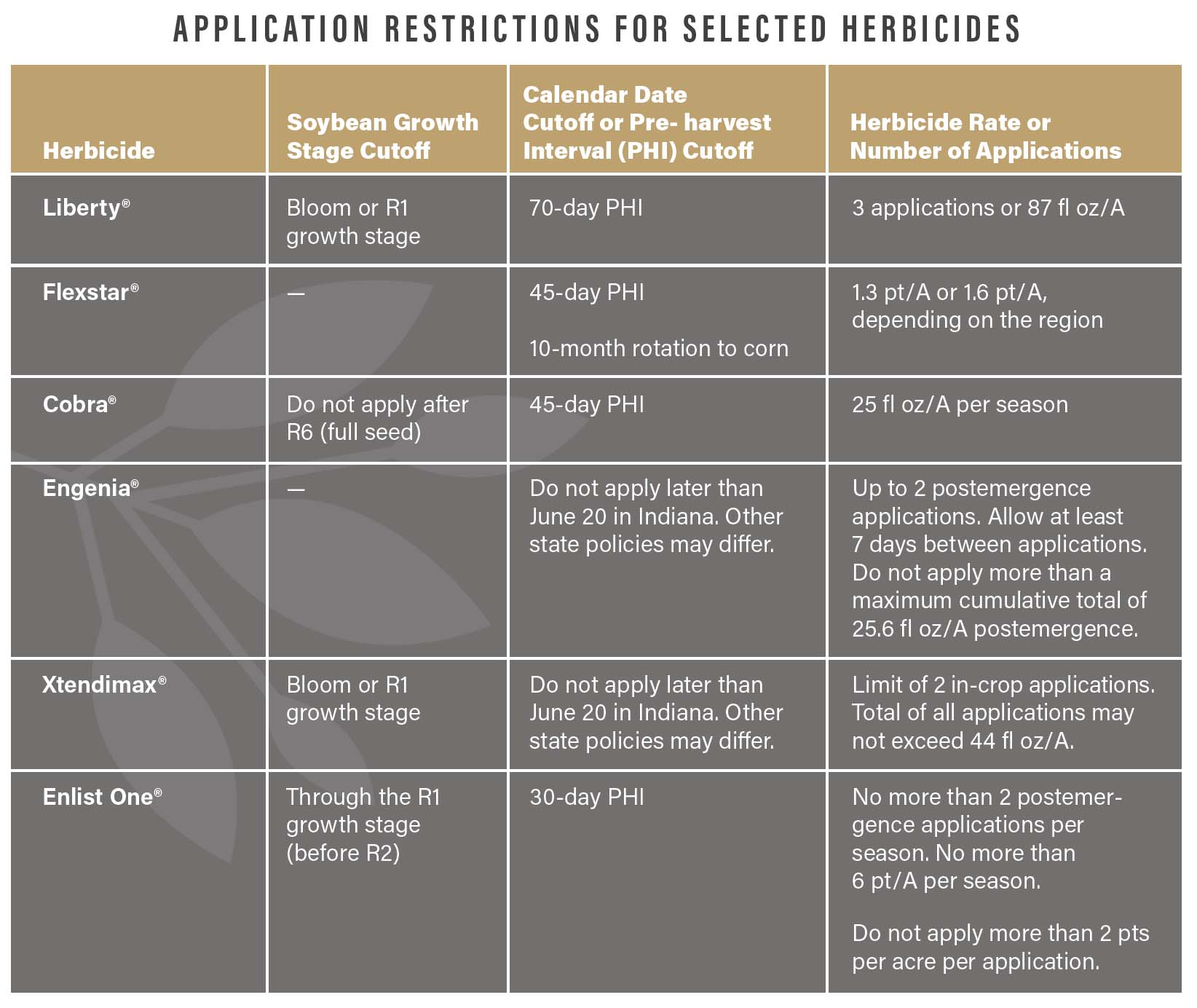
WHAT DOES THE RESEARCH SAY ?
Insufficient research accurately describes the timing of resprays, or what the optimum product choices are for given herbicide failure situations. This presented an opportunity for Purdue weed scientists to conduct field and greenhouse experiments to provide some guidance.The researchers simulated herbicide failures by applying reduced herbicide rates of Flexstar®, Liberty®, 2,4-D (Enlist One®), or dicamba (Engenia®) to 12-inch waterhemp, Palmer amaranth, and giant ragweed in the field. Of course, these methods would not be acceptable for commercial application and were used to create an artificial failure around 50 percent overall weed control.
The researchers identified subsequent herbicide respray treatments based on the most commonly used products and herbicide groups used for postemergence applications in soybeans: Liberty®, Flexstar®, Enlist One®, Engenia®, and Cobra®. Each herbicide was applied with appropriate adjuvants at different intervals following the initial application.
After initial treatment with Liberty® or Flexstar®, respray intervals included three (early), seven (middle), and 11 (late) days.
After initial treatment with dicamba or 2,4-D, respray intervals included seven (early), 14 (middle), and 21 (late) days.
The respray intervals roughly corresponded to a respray during the period when efficacy was uncertain and regrowth was not evident (early), a respray following the first signs of regrowth (middle), and a respray after substantial regrowth (late).
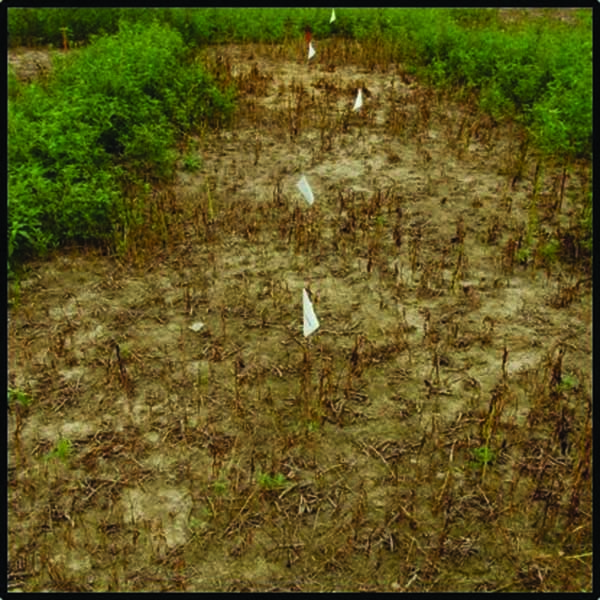 This photo shows weeds that were initially treated with Flexstar® (which failed), and then resprayed with Liberty.® The respray provided high levels of control. Notice the center area where nearly all the surviving waterhemp plants have been controlled.
This photo shows weeds that were initially treated with Flexstar® (which failed), and then resprayed with Liberty.® The respray provided high levels of control. Notice the center area where nearly all the surviving waterhemp plants have been controlled.
FINDINGS AND RECOMMENDATIONS FROM THE FIELD STUDIES
HERBICIDE
Purdue Weed Science researchers found that Liberty® resprays were the most effective following initial herbicide failure with Liberty® or Flexstar®. Cobra® is often the only option for respray applications to soybeans because labels limit the use of other herbicides. Unfortunately, Cobra® was the least effective and least consistent of all the herbicides tested. Flexstar®, Engenia®, and Enlist One® provided fair or good weed control after a respray in most situations. following failed applications of dicamba or 2,4-D, Flexstar® and Liberty® provided better weed control than Xtendimax® or Enlist One.®Purdue Weed Science researchers rated respray products on Palmer amaranth and waterhemp. They derived the rankings from a combination of both experimental data and best management practices.
In general, Liberty® was the best respray herbicide regardless of initial herbicide, but we recommend against sequential applications of Liberty® both to manage herbicide resistance and the fact that Flexstar® can also provide good to excellent control of surviving weeds.
If Liberty® is not a viable option, use Flexstar® if soybean growth stage and calendar date restrictions allow (avoid applications within 10 months of planting corn to reduce Flexstar® carryover concerns). If Flexstar® is not a viable option, use 2,4-D or dicamba for resprays if allowed by soybean traits, calendar dates (do not apply dicamba after June 20 in Indiana), and growth stage (do not apply at or after R1).

Does Initial Damage Affect Respray Success?
Purdue Weed Science researchers conducted greenhouse experiments to evaluate whether the level of initial plant injury from herbicide applications affected respray success.Researchers used Liberty® as the first spray at different rates on waterhemp and the weeds were allowed to regrow. They then made respray applications with different herbicides including Liberty®, 2,4-D, dicamba, Cobra® and Flexstar.® Regardless of the respray herbicide used, the more injured the plants, the better the results from resprays.
Therefore, there is a better chance to control weeds with a respray in cases when the weeds are very injured but still growing, than when the weeds are barely injured and begin regrowth quickly after the initial application.
 These photos show examples of plants just before a respray herbicide application. Plants with more injury (from left) are more easy to control than plants with less injury. The first application often determines how effective the second application will be.
These photos show examples of plants just before a respray herbicide application. Plants with more injury (from left) are more easy to control than plants with less injury. The first application often determines how effective the second application will be. Ultra Blazer® is another PPO inhibitor that has similar flexibility as Cobra.® We did not include it in our experiments, but in our experience, it performs similarly to Cobra® on waterhemp and Palmer amaranth.
While the results for Palmer amaranth and waterhemp indicate that repeated applications of the same herbicide can provide good weed control in soybeans (especially Liberty®) be aware that this action directly contradicts best weed management practices that aim to delay resistance evolution. Repeat applications of the same herbicide increases the risk of selecting for herbicide-resistant weeds, especially when dealing with species such as Palmer amaranth or waterhemp. That risk should be an important factor when choosing a respray product to use.

TIMING
Optimal timing for resprays varies by product.Following failed applications of dicamba and 2,4-D (systemic, auxin herbicides), researchers observed that intervals of seven to 14 days were more effective than resprays made 21 days after the initial failed application.
Following failed applications of non-systemic herbicides (including Flexstar® and Liberty®), researchers observed that intervals of three days resulted in poor performance in certain cases. For contact herbicides, maximum weed control was achieved when weeds were resprayed seven to 11 days after the initial application for contact herbicides. During this period, researchers observed new buds or leaves and as much as 1 to 2 inches of new growth. This is the ideal trigger for a respray since plant response to stress can be variable.
We recommend resprays based on plant appearance rather than the calendar date, because the optimal amount of regrowth can vary by a few days depending on conditions. This is why field scouting is so important to observe the progression of weed control. In the future, remote sensing such as drones, may play a role in assessing herbicide performance and helping growers decide what, if any, tactics they should implement to manage escaped weeds.
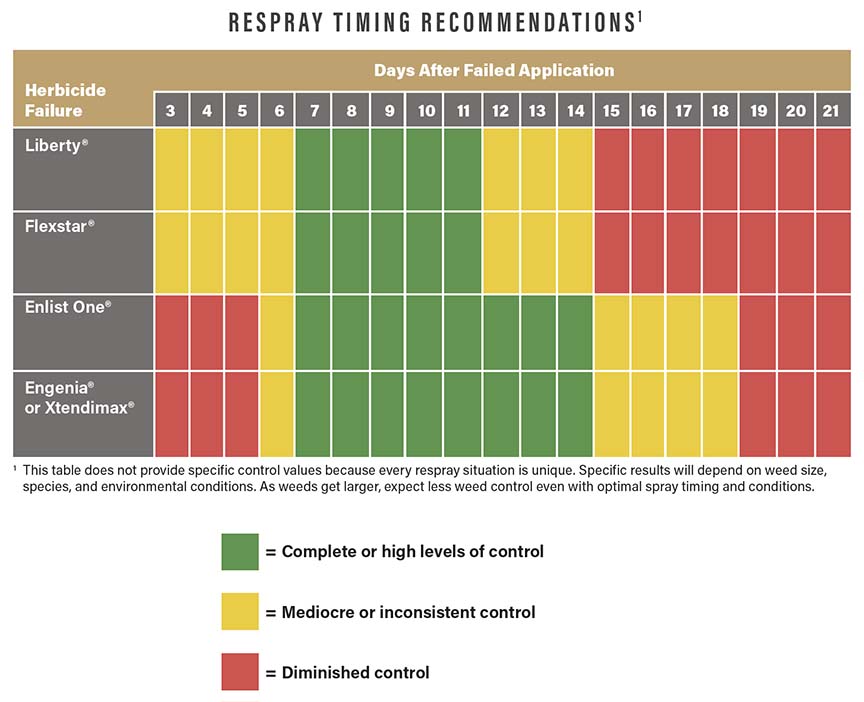
Conclusions
Applicators can influence how well herbicide programs work, so it is critical to take as much care as possible when making the initial POST herbicide application in soybean. As we’ve learned, the options for resprays can be limited.
Follow these guidelines when you make initial postemergence herbicide applications:
• Focus your attention on putting on the right herbicide, at the right rate, applied to weeds less than 4 inches tall to deal with the weed complex in your soybean field.
• Resist the temptation to wait and “let all the weeds emerge.” If you do, it will mean that the weeds that emerged first will be too large to control effectively.
• Pay attention to the most problematic weeds that are known to be herbicide resistant or difficult to control. These weeds should drive herbicide application decisions.
There are many factors that may cause foliar herbicide applications to fail. Follow these guidelines when deciding whether to respray in soybean:
• Scout fields to inspect herbicide activity and signs of weed recovery.
• Determine whether the weed pressure or weed seed production of the surviving weeds are enough to justify the additional expense of additional herbicide applications or if there are opportunities to implement other weed control tactics.
• Read herbicide labels and ask your county extension educator, agricultural retailer, herbicide manufacturer, or seed dealer about the potential damage from a respray to soybean yields.
• Understand and consider all label restrictions before respray applications to avoid carryover, crop injury, off-target movement, and label violations.
• Use herbicide group numbers (modes of action) that are different than the group number used for initial applications if they will be equally effective.
• Choose herbicides carefully. In short, Liberty® is currently the best option for resprays in most circumstances. However, resistance management considerations make Flexstar® the best choice for resprays when Liberty® fails. However, you cannot apply Liberty® as soon as the first soybean flowers are observed (up to, but not including the R1 growth stage).
• As a rule of thumb, respray weeds seven to 14 days after the first application (see the Respray Timing Recommendations table, page 19).
If herbicide options do not exist for controlling the remaining weeds in your field, then follow these guidelines for your future weed control program:
• Use the full rate of preemergence herbicides that have multiple effective modes of action.
• Use complementary tank mixes of postemergence herbicides to improve weed control consistency.
• Combine an overlapping residual with the postemergence herbicide application to prevent any late-emerging weeds.
• Consider planting cover crops or using other integrated weed management approaches to help suppress weeds.
• Rotate to field corn to utilize different herbicides that have other modes of action, such as atrazine and Group 27 herbicides (HPPD’s).
• Harvest weed-infested areas last and clean the combine thoroughly before leaving the infested fields.
Effective weed management requires proactive approaches that involve many complex decisions requiring multiple considerations. In order to make effective respray applications in soybean after initial applications fail, you must have the right product combination and timing. Timely field scouting, considering costs, understanding viable control tactics, and setting long-term weed management goals are important steps that help you develop a sustainable approach to tackling problematic weeds.
ACKNOWLEDGMENTS
We would like to thank Dawn Minns for graphic design.
Also, thank you to the following individuals who provided valuable comments and suggestions that improved the publication:
Greg Dahl, WinField United
Sarah Lancaster, Kansas State University
Travis Legleiter, University of Kentucky
Jeff Nagel, Ceres Solutions Cooperative
Eric Prostko, University of Georgia
Mark VanGessel, University of Delaware
DISCLAIMER
This publication is intended for educational purposes only. The authors’ views have not been approved by any government agency, business, or individual and cannot be construed as representing a perspective other than that of the authors. The publication is distributed with the understanding that the authors are not rendering legal or other professional advice to the reader, and that the information contained herein should not be regarded or relied upon as a substitute for professional consultation. The use of the information contained herein constitutes an agreement to hold the authors, companies, or reviewers harmless for liability, damage, or expense incurred as a result of reference to or reliance upon the information provided. Mention of a proprietary product or service does not constitute an endorsement by the authors or their employers. Descriptions of specific situations are included only as hypothetical case studies to assist readers of this publication and are not intended to represent any actual person, business entity, or situation. Reference in this publication to any specific commercial product, process, or service, or the use of any trade, firm, or corporation name is for general informational purposes only and does not constitute an endorsement, recommendation, or certification of any kind by Purdue University. Individuals using such products assume responsibility that the product is used in a way intended by the manufacturer and misuse is neither endorsed nor condoned by the authors nor the manufacturer.
